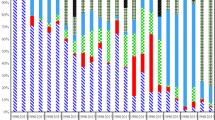Abstract
As the economies of ASEAN countries have grown, making energy has become one of their biggest concerns. This research examines CO2 emissions from electricity production sources in ASEAN countries. The paper examined data from 1971 to 2020 using methodologies such as ordinary least squares (OLS), fixed-effects (FE), random effects (RE), generalized methods of moments (GMM), and quantile regression (QR). Here, the Housman test reveals that FE is better than RE. The Hansen and Sargan tests show that all instruments are valid. According to the FE, RE, and GMM approaches, electricity generated from coal and oil deteriorates the environment. The use of coal and natural gas results in higher CO2 emissions, according to the OLS and QR methods. All available evidence suggests that coal-fired power generation has a higher impact on emissions than any other source. There is a strong correlation between CO2 and coal at 0.514. While CO2 and hydro have the strongest negative correlation, this is − 0.530. All regression methods assure that hydroelectricity generation can reduce CO2 emissions more than any other energy source. A 1% rise in hydro power reduces CO2 emissions by 0.576% in FE and by 0.05% in differenced GMM estimation. On the other hand, a 1% rise in coal-generated electricity increases CO2 emissions by 0.158% in FE and 0.017% in the differenced GMM estimation. The study suggests that CO2 emissions can be reduced without significantly affecting electricity generation if fossil fuel consumption is reduced. The government should launch public and private initiatives to promote renewable energy sources such as wind, hydropower, and solar to counteract climate change.



Source: Author's estimates

Source: Author's estimates


Similar content being viewed by others
Data availability statement
The data can be available on request.
References
Amri F (2017) Intercourse across economic growth, trade and renewable energy consumption in developing and developed countries. Renew Sustain Energy Rev 69:527–534
Arellano M, Bond S (1991) Some tests of specification for panel data: Monte Carlo evidence and an application to employment equations. Rev Econ Stud 58(2):277–297
Athanasoglou PP, Brissimis SN, Delis MD (2008) Bank-specific, industry-specific and macroeconomic determinants of bank profitability. J Int Financ Mark Inst Money 18(2):121–136
Awosusi AA, Adebayo TS, Altuntaş M, Agyekum EB, Zawbaa HM, Kamel S (2022) The dynamic impact of biomass and natural resources on ecological footprint in BRICS economies: a quantile regression evidence. Energy Rep 8:1979–1994
Aydin M (2019) The effect of biomass energy consumption on economic growth in BRICS countries: a country-specific panel data analysis. Renew Energy 138:620–627
Cho Y, Lee J, Kim TY (2007) The impact of ICT investment and energy price on industrial electricity demand: dynamic growth model approach. Energy Policy 35:4730–4738
Dantama YU, Abdullahi YZ, Inuwa N (2012) Energy consumption-economic growth nexus in Nigeria: an empirical assessment based on ARDL bound test approach. European Sci J 8(12)
Hansen LP (1982) Large sample properties of generalized method of moments estimators. Econ J Econ Soc 50:1029–1054
Huang L, Krigsvoll G, Johansen F, Liu Y, Zhang X (2018) Carbon emission of global construction sector. Renew Sustain Energy Rev 81:1906–1916
Hon CL (2022) Decarbonization roadmaps for ASEAN and their implications. Energy Rep 8:6000–6022 (ISSN 2352-4847, rw)
IEA (2019) Southeast Asia energy outlook 2019, IEA, Paris. https://www.iea.org/reports/southeast-asia-energy-outlook-2019. Accessed 10 Feb 2022
Kim H, Kim M, Kim H, Park S (2020) Decomposition analysis of CO2 emission from electricity generation: comparison of OECD countries before and after the financial crisis. Energies 13(14):3522
Kristmannsdottir H, Armannsson H (2003) Environmental aspects of geothermal energy utilization. Geothermics 32(4–6):451–461
Nag B, Parikh J (2000) Indicators of carbon emission intensity from commercial energy use in India. Energy Econ 22(4):441–461
Nguyen KH, Kakinaka M (2019) Renewable energy consumption, carbon emissions, and development stages: some evidence from panel cointegration analysis. Renew Energy 132:1049–1057
Ozturk I (2010) A literature survey on energy–growth nexus. Energy Policy 38(1):340–349
Shisong C, Wenji Z, Hongliang G, Deyong H, You M, Wenhui Z, Shanshan L (2018) Comparison of remotely sensed PM2. 5 concentrations between developed and developing countries: results from the US, Europe, China, and India. J Clean Prod 182:672–681
Talbi B (2017) CO2 emissions reduction in road transport sector in Tunisia. Renew Sustain Energy Rev 69:232–238
The World Bank, World Development Indicators (2021) Energy consumption, Atlas method [Data file]. http://data.worldbank.org/indicator/ASEAN.EC.PCAP.CD. Accessed 10 Feb 2022
Wang W, Mu H, Kang X, Song R, Ning Y (2010) Changes in industrial electricity consumption in china from 1998 to 2007. Energy Policy 38:3684–3690
Wang Y, Xie T, Yang S (2017) Carbon emission and its decoupling research of transportation in Jiangsu province. J Clean Prod 142:907–914
Yoo SH (2005) Electricity consumption and economic growth: evidence from Korea. Energy Policy 33:1627–1632
Yu Z, Liu W, Chen L, Eti S, Dinçer H, Yüksel S (2019) The effects of electricity production on industrial development and sustainable economic growth: a VAR analysis for BRICS countries. Sustainability 11(21):5895
Acknowledgements
We are thankful to world bank for data.
Author information
Authors and Affiliations
Contributions
LCV—methodology, writing. MAI—data collection, software. AR—writing, editing. MMR—editing, supervision.
Corresponding author
Ethics declarations
Conflict of interest
The authors declare no competing inerests.
Ethical consent
We declare that we have no human participants, human data, or human tissues.
Consent for publication
N/A.
Rights and permissions
Springer Nature or its licensor holds exclusive rights to this article under a publishing agreement with the author(s) or other rightsholder(s); author self-archiving of the accepted manuscript version of this article is solely governed by the terms of such publishing agreement and applicable law.
About this article
Cite this article
Voumik, L.C., Islam, M.A., Rahaman, A. et al. Emissions of carbon dioxide from electricity production in ASEAN countries: GMM and quantile regression analysis. SN Bus Econ 2, 133 (2022). https://doi.org/10.1007/s43546-022-00318-y
Received:
Accepted:
Published:
DOI: https://doi.org/10.1007/s43546-022-00318-y




